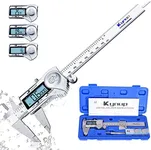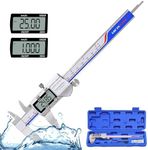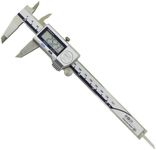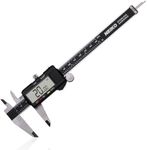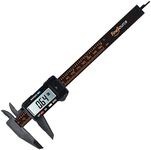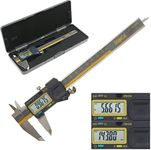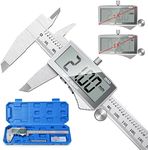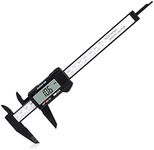Buying Guide for the Best Digital Calipers
Choosing the right digital calipers is all about understanding what you’ll be measuring and how precise you need your measurements to be. Digital calipers are handy tools for anyone who needs to measure objects with accuracy, whether for DIY projects, engineering, or hobbies. The best approach is to think about the size of the objects you’ll measure, how often you’ll use the tool, and the level of detail you require. By focusing on the key specifications, you can find a caliper that fits your needs and is comfortable to use.Measuring RangeThe measuring range tells you the smallest and largest size the caliper can measure, usually given in millimeters or inches. This is important because it determines what objects you can measure with the tool. Calipers typically come in ranges like 0-150mm (6 inches), 0-200mm (8 inches), or 0-300mm (12 inches). If you mostly measure small items like coins or screws, a 150mm range is usually enough. For larger objects, consider a bigger range. Think about the largest item you might need to measure and choose a caliper that covers that size comfortably.
Accuracy and ResolutionAccuracy is how close the caliper’s measurement is to the true value, while resolution is the smallest increment it can display. These are crucial for tasks where precision matters, like engineering or machining. Accuracy is often listed as ±0.02mm or ±0.001 inch, and resolution might be 0.01mm or 0.0005 inch. For general DIY or household use, standard accuracy and resolution are usually fine. If you need very precise measurements, look for higher accuracy and finer resolution. Match the level of precision to the demands of your projects.
Build MaterialThe material of the caliper affects its durability and feel. Common materials include stainless steel, carbon fiber, and plastic. Stainless steel calipers are sturdy and long-lasting, making them ideal for frequent or professional use. Carbon fiber and plastic calipers are lighter and may be more comfortable for occasional use, but they can be less durable. If you need a tool that will last and withstand rough handling, go for stainless steel. For light, occasional tasks, lighter materials may be sufficient.
Display Type and SizeThe display shows your measurement, and its size and clarity can make a big difference in ease of use. Larger, clearer displays are easier to read, especially in low light or for those with vision challenges. Some displays also offer features like backlighting. If you often work in dim environments or want to avoid eye strain, look for a caliper with a large, easy-to-read display. For occasional or simple tasks, a standard display may be enough.
Zero Setting and Unit ConversionZero setting lets you reset the measurement at any point, which is useful for comparing sizes or measuring differences. Unit conversion allows you to switch between metric and imperial units with a button. These features add convenience, especially if you work with different measurement systems or need to make relative measurements. If you need flexibility or work on varied projects, these features are very helpful. For single-purpose use, they may be less important.
Battery Life and Power SourceDigital calipers run on batteries, and battery life can affect how often you need to replace or recharge them. Some calipers have auto-off features to save power. If you use your caliper frequently or for long periods, look for models with longer battery life or easy-to-find batteries. For occasional use, battery life may be less of a concern, but it’s still good to check how easy it is to replace the battery.
